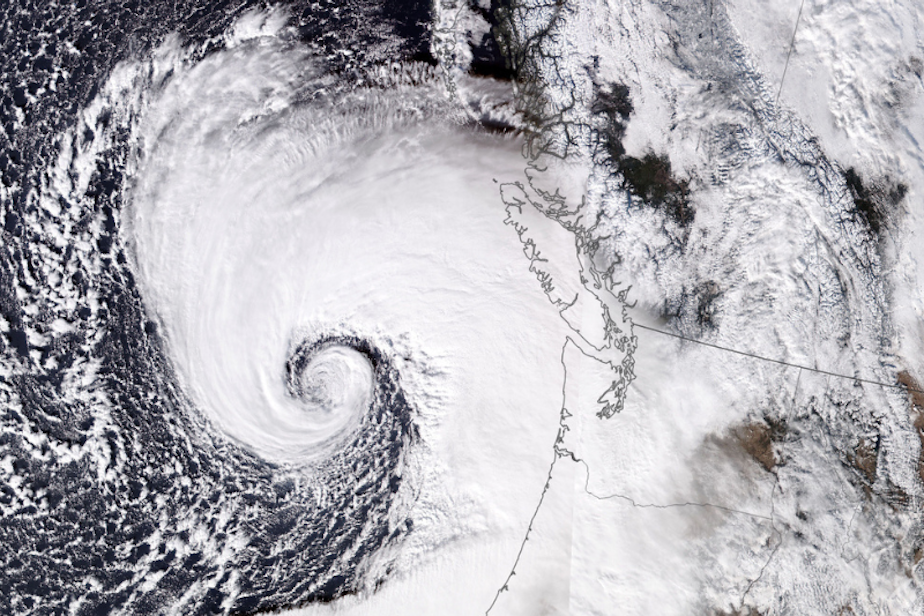How to prepare for the Seattle area’s next big storm

Last week’s bomb cyclone — plus a second windstorm — were a reminder to many in the Pacific Northwest that bad weather can mean days without power.
Ice and snow storms are another winter hazard, sometimes knocking out power and frequently snarling transportation and supply chains. And don't forget the ever-present threat of The Big One.
It pays to be prepared for emergencies. Many people are not.
RELATED: How to find warmth, electricity, and other storm resources in the Seattle area
Susanna Trimarco, the public outreach and education coordinator for King County's Office of Emergency Management, said that’s completely understandable.
Sponsored
“It can be really overwhelming to hear this list of things you should do, things you should have,” she said.
But it’s never too late to begin.
Making a list — like this one from King County — and checking off items one at a time is the best way to get prepared and stay prepared for the region’s next emergency.
“That's really the most important part of preparedness,” Trimarco said. “You keep working at it really incrementally."
Sponsored

Start with emergency kits
An emergency “go” kit should be at the top of preparedness lists. This is a bag filled with basic survival needs – some food and water, a first aid kit – and copies of important documents. A few comfort items don’t hurt either.
“In the winter, I keep a pair of wool socks in mine. It's always something that I want to kind of be updating and checking in on, especially as seasons change,” Trimarco said.
For winter storms, an in-home emergency kit is more useful, and that should be the next priority. It should include stores of shelf-stable foods that don't need to be cooked, like granola bars and dried fruits.
Sponsored
RELATED: Cold nights forecast for Western Washington in the wake of damaging winds
Also include gear that could be useful if the power goes out, like flashlights, lighters, and a camp stove.
“There's a lot of people in this area who recreate and go camping and backpacking, and those are great supplies for emergencies,” Trimarco said.
Keeping some emergency supplies in your car is also good practice.
Stay hydrated
Sponsored
While power outages won’t affect most households’ water supplies, freezing temperatures or earthquakes certainly can.
The CDC recommends budgeting one gallon of water per day, per person, for drinking as well as hygiene. For a family of four, two weeks of water stores would be 56 gallons.
“I can't store quite that much, let alone keep up on cycling the water in and out. So, I'm also thinking about ways to purify and sanitize water,” Trimarco said.
RELATED: 2 killed, hundreds of thousands without power in Western Washington amid pacific bomb cyclone winds
Water filters and purification tablets are a good addition to emergency kits, and Trimarco suggested getting familiar with techniques like boiling water and sanitizing water with bleach. If a winter storm is in the forecast, consider storing extra water just in case.
Sponsored
“I like to fill up a couple pots and vases and jars in my house,” Trimarco said. “Just some immediate, quick backup supply that you don't have to store year round.”

Stock up
Along with having distinct emergency kits, Trimarco recommended keeping a surplus of everyday supplies on hand. Having plenty of toilet paper, cleaning supplies, garbage bags, and paper towels can be handy if stores run out.
Another pro-tip: keep gas tanks at least half full.
RELATED: Powerless Tesla drivers storm Seattle-area grocery store to recharge during outages
“It's easy to think that that might only be useful in an evacuation, but it actually could be really helpful in a situation like this [storm], where you have no power. You're cold, you need to charge your phone. You can go turn on your car for half an hour,” Trimarco said.
Plan for communications to be challenging
Storms and other emergencies often wipe out power and, as the Seattle region saw last week, cell service. Trimarco suggested including charging cables and rechargeable power banks as part of an emergency supply.
Turn devices to low power mode and reduce brightness. In case cell phones lose power, write down important numbers like family members and local services.
RELATED: Winter storms sweep across the U.S. while a new system is expected for Thanksgiving
“Cell service can be challenging in these types of situations,” Trimarco said. “Try sending a text message. That uses a lot less cell bandwidth than making a phone call or something like that.”
Hand-cranked or battery operated radios, like a NOAA emergency weather radio, are another way to keep up with emergency situations.
Consider signing up for local emergency alert systems like Alert King County and Alert Seattle.





